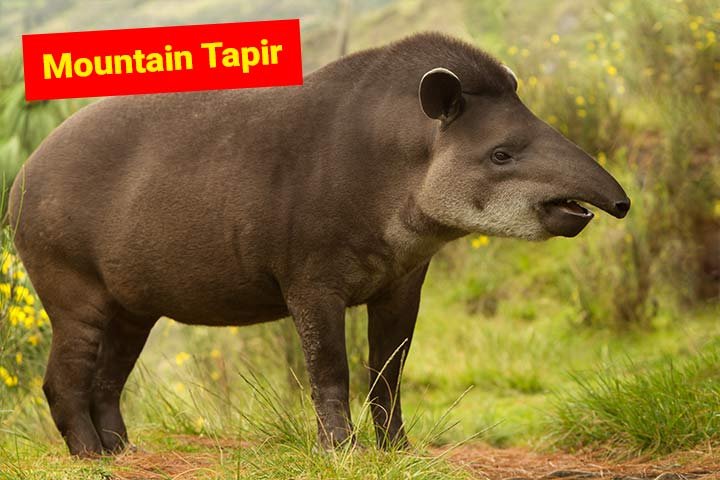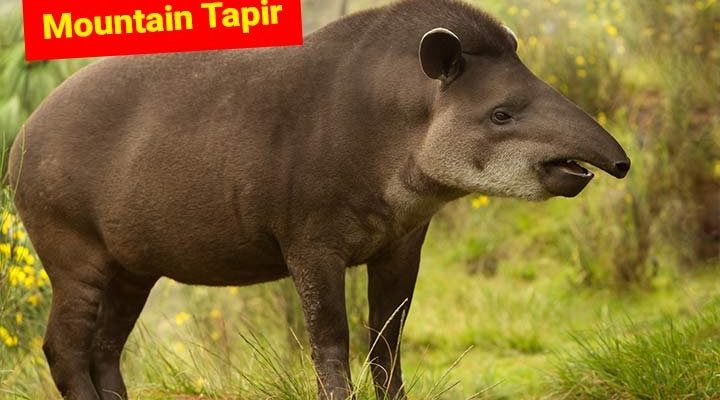
Just like us, mountain tapirs navigate their world using a mix of instinct and learned behaviors. They have to be clever to find food, avoid predators, and adapt to changing environments. Understanding their intelligence gives us insight into their lives and challenges, showing us that there’s much more to these creatures than meets the eye. So, let’s explore what makes the mountain tapir tick—their smarts, strategies, and quirks all come together to paint a picture of an animal that’s more than just a cute face.
What Is a Mountain Tapir?
Mountain tapirs, also known as the Andean tapir, are one of the four tapir species found around the world. They’re typically smaller than their relatives, standing about 3 feet tall at the shoulder and weighing between 400 to 800 pounds. With their characteristic short legs and elongated snouts, these creatures are perfectly adapted to their mountainous habitats in Colombia, Ecuador, and northern Peru.
They prefer high-altitude forests and grasslands where they can munch on leaves, fruits, and other vegetation. This brings us to an interesting point about their diet: they are herbivores, and their food choices are vital for their survival. Because they graze on a wide variety of plants, mountain tapirs play a crucial role in maintaining the health of their ecosystems. Their foraging behavior helps seed dispersal and promotes the growth of diverse plant species, so they contribute to the biodiversity of their habitats.
You might be wondering how they manage to thrive in such a challenging environment. Well, their adaptations go beyond just their diet. Their thick fur keeps them warm, while their cloven hooves provide stability on rocky terrain. All these features come together to create a resilient creature that knows how to navigate its space.
Cognitive Abilities of Mountain Tapirs
So, how do we measure intelligence in animals like mountain tapirs? Unlike dogs or primates, tapirs don’t perform tricks or solve puzzles in front of scientists. However, we can look at their behaviors and adaptability to gauge their smarts. Mountain tapirs exhibit a range of behaviors that suggest a level of cognitive sophistication. For one, they are known to use their sense of smell and hearing to navigate their surroundings effectively.
In addition, mountain tapirs have been observed showing problem-solving skills, especially when it comes to finding food. They’ll often explore various methods to reach their desired meals, whether that means moving rocks or using their long snouts to get into hard-to-reach places. This ability to adapt and innovate is an indicator of intelligence, showcasing their capability to learn from their environment.
Moreover, mountain tapirs often exhibit social behaviors, particularly during the mating season. They establish territories and communicate through vocalizations, which suggests they can recognize each other and understand social dynamics. This level of interaction indicates a degree of social intelligence, making them more than just solitary creatures.
Mountain Tapirs and Their Behavior in the Wild
When it comes to behavior, mountain tapirs are mostly crepuscular, meaning they’re most active during dawn and dusk. This behavior not only helps them avoid predators but also aligns with the activity patterns of their primary food sources. It’s fascinating how their lifestyle choices are directly tied to survival strategies.
During the day, you might find them resting, often hidden in the dense undergrowth. This camouflage helps protect them from predators like jaguars and pumas. In fact, their cautious nature is another testament to their intelligence. They often survey their surroundings before moving on, exhibiting a level of awareness that is critical for survival.
Their social interactions play a critical role in their lives, too. While mountain tapirs are generally solitary, they do come together for mating or raising young. During these times, they demonstrate a variety of vocalizations and body language, suggesting a form of communication that’s quite developed. This leads us to consider how their emotional intelligence might also play a part in their social behaviors, adding another layer to their cognitive abilities.
The Importance of Habitat for Cognitive Development
The habitats of mountain tapirs are not only essential for their physical needs but also for their cognitive development. These animals rely on complex environments to stimulate their brains. Adequate vegetation, rocky terrains, and diverse ecosystems present challenges that tapirs must keep overcoming to survive.
For instance, the variety of food sources in their mountainous forests encourages them to explore and engage with their surroundings. This exploration is crucial for learning; it teaches them not just about food availability but also about potential dangers. Young tapirs learn from their mothers which plants are safe to eat and where to find them. This knowledge is invaluable, impacting their survival rates as they mature.
Additionally, the changing seasons in these high-altitude environments pose new challenges for tapirs. They must adapt to fluctuations in weather and food availability, pushing them to refine their problem-solving skills throughout their lives. It’s like a constant test of wits, ensuring that only the smartest survive and thrive.
Conservation Status and Its Impact on Behavior
Unfortunately, mountain tapirs face several threats, including habitat destruction and poaching. This not only puts their physical survival at risk but can also impact their cognitive abilities and behaviors. With fewer resources and increased stress from human activities, their problem-solving skills may be diminished.
Conservation efforts are crucial in ensuring that these animals can maintain their natural behaviors. Protected areas help provide safe spaces where tapirs can thrive, learn, and adapt without the pressures of human interference. Initiatives focused on habitat restoration and community education are vital to help locals understand the importance of preserving these magnificent creatures and their environments.
Here’s the thing: when habitats are compromised, so are the unique behaviors that define mountain tapirs. Ensuring their survival means advocating for conservation practices that allow them to live freely and maintain their cognitive abilities.
Mountain tapirs may not wear their intelligence on their sleeve like some other animals, but their cognitive abilities are impressive in their own right. From their problem-solving skills to their social behaviors, they showcase a unique form of intelligence that helps them navigate the challenges of life in the Andes.
Understanding how smart a mountain tapir is not just an academic exercise—it has real-world implications for conservation efforts. By protecting their habitats and ensuring their survival, we ensure that these remarkable creatures can continue to thrive and adapt. Whether you’re a wildlife enthusiast or just curious about these animals, appreciating their cognitive abilities can deepen your understanding of the natural world and the interconnectedness of all living things. So next time someone asks you about the smarts of a mountain tapir, you can confidently share just how fascinating and capable they truly are.

